COUNTRY CHICKEN BREEDS AND REARING PRACTICES:
The following content is all about Country Chicken Breeds and Rearing Practices.
Introduction to Chicken Rearing: The poultry industry started in India some 5000 years ago. It was traced during the Mauryan Empire. The commercial industry began in the 19th century. It is estimated that the poultry sector in India is growing at a faster rate and over the past ten years it has contributed 229 million to the gross national product (GNP). Poultry practices in India are now a commercial activity. The industry is expected to produce 1800 million kg of meat, 40 billion eggs annually along with providing employment to 3 million people across the country. The factors that influence the growth of the poultry industry are a rise in market demand, change in food habits, private investments, and export.
COUNTRY CHICKEN BREEDS
Chicken is classified based on two things that are egg and meat. Egg-type chicken is developed and maintained for the production of egg. The meat varieties of chicken are mainly used for their meat and they are classified as broilers, fryers, roasters, etc. The native egg-type chicken breeds in India are Aseel, Frizzle, Kadaknath, and Naked neck. The commercial meat-type chickens in India are B-77, caribro-91, caribro multicoloured, caribro naked necked, and Varna. The four pure breeds of chicken found in India are:
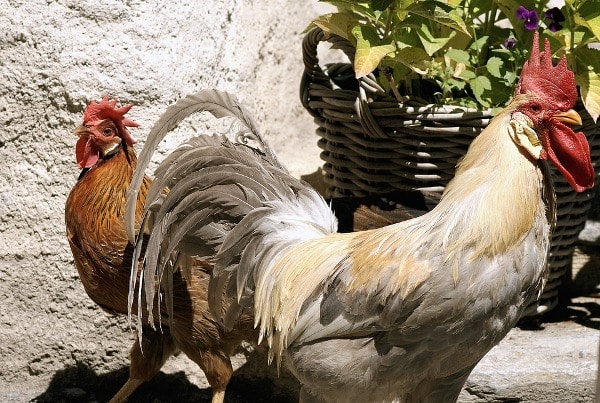
Pure Country Chicken Breeds – Aseel: Found in Andhra Pradesh, Uttar Pradesh, and Rajasthan. This chicken variety has good stamina and fighting abilities. They have broad and shorter bodies with a long straight and well apart legs. The weight of a male bird is 4-5 kg, a hen is 3-4 kg, a cockerel is 3.5-4.5 kg and a pullet is 2.5-3.5 kg.
Pure Country Chicken Breeds – Kadaknath: It is a fowl with black flesh hence addressed as kalamasi also. They lay eggs that are light brown in color. The comb, wattles, and tongue are purple in color. This variety is disease resistant in the natural environments but when put under rearing conditions it may be susceptible to Marek’s disease. The egg production capacity of Kadaknath is 80 eggs per year.
Pure Country Chicken Breeds – Chittagong: Also known as Malay chicken. It is considered the tallest breed. It is well muscled, has prominent eyebrows, has a featherless shank and upright stance. It is estimated to lay 70-120 eggs annually.
Pure Country Chicken Breeds – Busra: It is native to Maharashtra and Gujarat. It has a white and black mixed feathered plumage. It has a yellow shank and beak with red wattles. Eggs are light brown in color and weigh around 28-38 grams. The annual egg production capacity is 40-55.
The breeds of chicken mentioned by the Central Avian Research Institute (CARI) are:
An Egg Producing Desi Type Country Chicken Breeds:
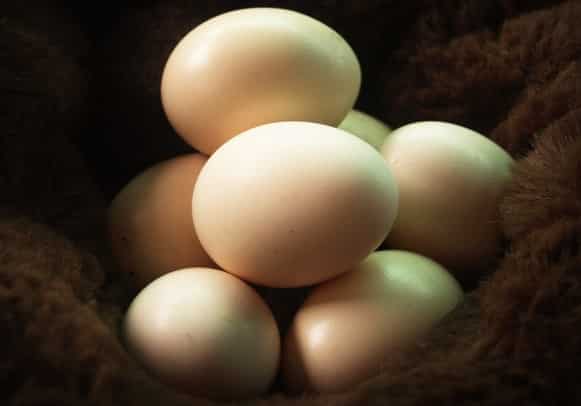
Country Chicken Breeds – CARI NIRBHEEK: It is a crossbreed of Aseel and Cari red. They have high fighting characteristics and can adapt to any climatic zone.
- Bodyweight at 20 weeks: 1847 g (male) and 1350 g (female).
- Age at maturity: 176 days.
- Annual egg production: 198.
- Egg weight at 40 weeks: 54 grams.
- Fertility: 88%.
- Hatchability FES: 81%.
Country Chicken Breeds – CARI SHYAMA: It is a crossbreed of Kadakanath and Cari red. The internal organs of this variety also have a darker pigmentation and are mostly preferred by the tribal population for the cure of human ailments. Mostly found in Madhya Pradesh, Rajasthan, and Gujarat.
- Bodyweight at 20 weeks: 1460 g (male) and 1120 g (female).
- Age at maturity: 170 days.
- Annual egg production: 210.
- Egg weight at 40 weeks: 53 grams.
- Fertility: 85%.
- Hatchability FES: 82%.
Country Chicken Breeds – HITCARI: They are the crossbreed of Indian native naked neck and Cari red. They have 30-40 % fewer feathers on the body which makes them adaptable to tropical climates. They are considered best to be reared in hot humid coastal regions.
- Bodyweight at 20 weeks: 1756 g (male) and 1320 g (female).
- Age at maturity: 178 days.
- Annual egg production: 200.
- Egg weight at 40 weeks: 61 grams
- Fertility: 92%.
- Hatchability FES: 81%.
Country Chicken Breeds – UPCARI: It is a crossbreed of Indian native frizzle with Cari red. They have a single comb and are multicolored with medium body size. Having a frizzle plumage helps them to dissipate heat and adjust to the tropical and arid climates. The UpCari chicken is again of four types based on the crossbreed of dehlam red with Kadaknath, Aseel, Frizzle, and Naked neck. The annual egg production is 180 eggs and each egg weighs around 55 g in 40 weeks.
An Egg Laying Type Country Chicken Breeds:
Country Chicken Breeds – CARI GOLD:
- First egg produced in 18 weeks.
- Peak production: 150 days.
- Average egg weight: 57 grams.
- Liveability: 96%.
- Egg production in 72 weeks: 298 eggs.
Country Chicken Breeds – CARI DEVENDRA: It is a dual-purpose chicken. It is a crossbreed of synthetic broiler as male and Rhode Island Red as female. Since it has a lower carcass and abdominal fat, it is suitable for consumption and it also has moderate egg production capacity.
- Bodyweight at 12 weeks: 1800 grams.
- Age at maturity: 160 days.
- Annual egg production: 200.
- Egg weight at 40 weeks: 54 grams.
- Liveability: 94%.
Country Chicken Breeds – CARI SONALI: It is easy to handle chicken. Has excellent internal quality, lays brown eggs, and is rated high in egg production. Maximum production occurs in 29 weeks. This is also called the Golden-92
- The first egg is produced: 19 weeks.
- Egg weight at 40 weeks: 54 grams.
- Liveability: 96%.
The Broiler Type Country Chicken Breeds:
Country Chicken Breeds – CARIBRO VISHAL: It is also addressed as CARIBRO-91.
- Weight at day old: 43 grams.
- Weight at 6 weeks: 1650- 1700 grams.
- Weight at 7 weeks: 2100 -2200 grams.
- Dressing percentage: 75%.
- Liveability: 97-98%.
- Feed conversion ratio at 6 weeks: 1.94.
Country Chicken Breeds – CARI RAINBRO: It is also addressed as B-77.
- Weight at day old: 41 grams.
- Weight at 6 weeks: 1300 grams.
- Weight at 7 weeks: 1600 grams.
- Dressing percentage: 73%.
- Liveability: 98-99%.
- Feed conversion ratio at 6 weeks: 2.3.
Country Chicken Breeds – CARIBRO DHANRAJA: it is a commercial crossbreed of colored synthetic males and females. It cannot withstand adverse environmental conditions. It has a multi-colored plumage.
- Weight at day old: 46 grams.
- Weight at 6 weeks: 1500-1700 grams.
- Weight at 7 weeks: 2000-2125 grams.
- Dressing percentage at 6 weeks: 73-75.
- Liveability at 6 weeks: 96-98%.
- Feed conversion ratio at 7 weeks: 1.92.
Country Chicken Breeds – CARIBRO MRITUNJAI: it is a crossbreed of naked neck and colored and white synthetic broiler. It is adaptable to high temperatures and is suitable for rearing in hot and dry areas.
- Weight at day old: 38-42 grams.
- Weight at 6 weeks: 1400 -1500 grams.
- Weight at 7 weeks: 1800 -2000 grams.
- Dressing percentage at 6 weeks: 75-77.
- Liveability at 6 weeks: 97-98.
- Feed conversion ratio at 6 weeks: 1.95.
There is a certain breed of chicken based on the location within India. The Jharsim is a rural-specific breed found in Jharkhand. The Kamrupa is a dual variety breed farmed in Assam and the Pratapdhan is also a dual-purpose chicken breed local to Rajasthan. The details of these varieties are listed below.
Country Chicken Breeds – Jharsim: This chicken breed is developed by the All India Coordinated Research Project on Poultry Breeding at Ranchi. It is a dual-purpose breed native to Jharkhand and derives its name from the local dialect. They survive on low nutrition, grow faster, produce eggs at an optimum level and adapt well to the climatic conditions of the location. These chickens are a source of income to the tribal population in that area.
- Weight of the bird at 6 weeks: 400-500 grams.
- Weight of the bird at full maturity: 1600-1800 grams.
- First Egg production: 180 days.
- Egg weight at 40 weeks: 55 grams.
- Egg production annually: 165-170 eggs.
Country Chicken Breeds – Kamrupa: This multicolored chicken breed is developed by the All India Coordinated Research Project on Poultry Breeding in Assam. It is a crossbreed of three different chicken breeds: the Assam local (25%), colored broiler (25%), and the dhalem red (50%). This variety has colored plumage, medium body weight, long shanks, and produces an average amount of eggs.
- Weight of the bird at 8 weeks: 500- 650 grams.
- Weight of the bird at 20 weeks: 1300-1500 grams.
- Egg weight at 40 weeks: 52 grams.
- Egg production annually: 118-130 eggs.
- Weight of the male bird at 40 weeks: 1800-2200 grams.
Country Chicken Breeds – Pratapdhan: this is a dual-purpose chicken developed by the All India Coordinated Research Project on Poultry Breeding in Udaipur. They are capable to survive adverse climatic conditions and do well on low nutrition.
- Weight of the bird at 20 weeks: 1478-3020 grams (male) and 1283 – 2736 grams (female).
- First Egg production: 170 days.
- Egg weight at 40 weeks: 50 grams.
- Egg production annually: 161 eggs.
The Directorate of Poultry Research (ICAR), Hyderabad has researched and developed certain breeds of chicken that are a local farming variety and are also profitable.
Country Chicken Breeds – GRAMAPRIYA: This variety is the egg type and was developed for rural and tribal farming options. The chicken has colored plumage and lays brown eggs.
- Annual egg production: 230 -240 grams.
- Free-range production: 160 – 180 eggs.
- Weight of bird at 15 weeks: 1.2 -1.5 kg (male).
- Weight of the egg: 57- 59 grams.
Country Chicken Breeds – SINIDHI: It is a rural dual-purpose production breed of chicken. It has medium weight and is suitable for being reared in Tripura, Jharkhand, and Andhra Pradesh.
- Full production cycle: 72 weeks.
- Weight at 6 weeks: 650 grams.
- Weight at 15 weeks: 2353 g (male).
- Maturity age: 161 days.
- Egg production at 40 weeks: 90 eggs.
- Annual egg production: 228 eggs.
- Liveability: 95%.
Country Chicken Breeds – VANARAJA: It is multi-colored dual-purpose chicken with attractive plumage. It can be reared in free areas and has better immunity. They have moderate weight at 8 weeks with normal feeding conditions. In a laying cycle, this variety of chicken lays 160 -180 eggs. They have self-protection ability which is a major advantage for backyard rearing.
Country Chicken Breeds – KRISHIBRO: It is a broiler variety of chicken that has high resistance against common diseases like Ranikhet and bursal. It adapts well to its surroundings and has a better survival rate. It can be reared in tropical weather conditions. This breed attains full weight by 6 weeks and liveability is 97%. The feed conversion ratio is 2.2.
Country Chicken Breeds – SWARNADHARA: It is a breed of chicken developed by the Karnataka Veterinary Animal Fishery Science and University, Bangalore. It is reared in the backyard and has a good egg production capability which is better than other breeds.
- An annual egg production: 180-190 eggs.
- Full maturity age: 22-23 weeks.
- Weight at full maturity: 3 kg (a hen) and 4 kg (male chicken).
REARING PRACTICES OF THE CHICKEN BREEDS
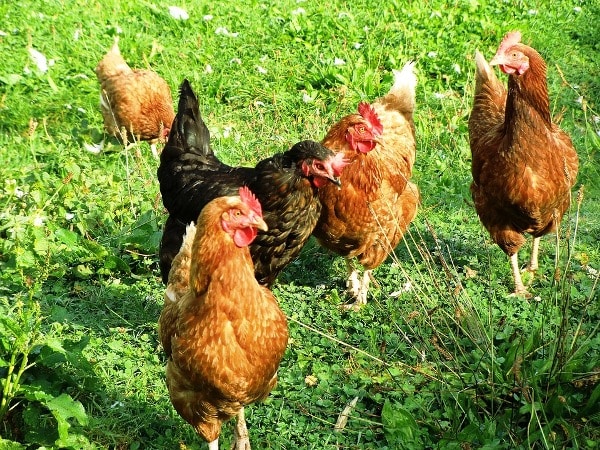
Country Chicken Breeds Housing: The country chicken is an adaptable and sturdy breed that does not require special housing preparations. Simple houses that protect these chickens from harsh atmospheric conditions are enough for survival. If the Chicken is reared in a free range then they are let loose in the day and kept in pens during the night. The houses for these birds are built in the north-south direction to facilitate air circulation and avoid direct sunlight. Materials like bamboo, wood, grass, etc are used to build sheds. There should not be water accumulation in the houses where the birds are reared. To keep the place warm and lighted, bulbs are fitted to the ceiling.
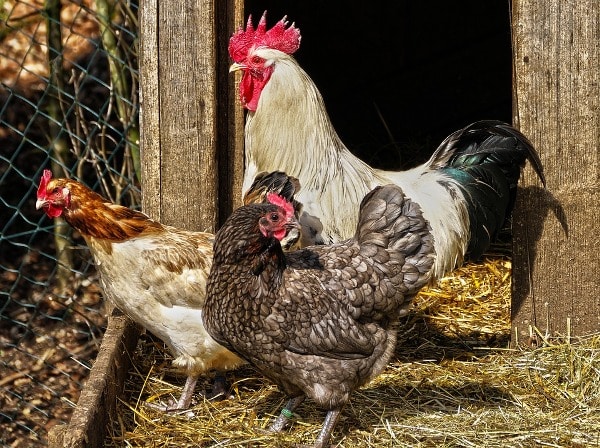
Country Chicken Breeds Farm Feed: The nutrients required by the birds are got through worms, insects, weeds, crop residue, grains, household waste, etc. while scavenging in the open. In addition to these nutrients, the birds are also fed with rice bran, broken rice, and groundnut straw. The feed gets fungal contamination when stored beyond thirty days during the rainy season. 30-60 g of extra feed is supplied to the birds when needed. To replenish the vitamin, mineral, and salt requirements the feed is formulated with wheat bran, fish meal, shell grit, limestone, and maize. There are three stages of growth during which the feed is managed. At the starter stage, 20% protein is required and the weight of the chicken is expected to reach 1.3 to 2.4 kg. During the grower stage and laying stage, the protein requirement is 16% and 18% respectively.
Country Chicken Breeds Brooding: A method of raising the chicks in a proper way after they hatch. A minimum of two weeks is required for a chick to develop its thermoregulatory system and its own equilibrium with environmental elements. As soon as they hatch the chicks have no control of their body temperature, therefore some provision has to be arranged for maintaining their body temperature. This is called brooding. There are two types of brooding mechanisms:
Country Chicken Breeds Natural Brooding: A hen is given with all facilities like food and water. Broody hens are sitters for the incubated improved variety of eggs. One broody hen takes care of 12-15 chicks at a single time. The chicks scavenge with the mother after hatching and during the night they have special provisions in the hen.
Country Chicken Breeds Artificial Brooding: Baby chicks are reared without the broody hen. Artificial heat is provided to maintain the temperature of the brooding area. ‘Bukharies’ is designed with kerosene, charcoal, saw-dust, etc. as heating materials where the temperature in the first week is 95 Degrees Fahrenheit. The temperature is reduced by 5 degrees until the 6th week. The average heat required during the brooding stage of chicks is 2 watts.
When the chicken is brought to the farm they have to be managed well and kept healthy. There are few things that have to be considered while rearing these chicks.
Brooding and Feeding of Country Chicken Breeds: The temperature of the brooding area has to be maintained properly in the artificial brooders. The food and water is supplied at least twice a day or as required. Cups are placed in the area to stimulate the water intake of chicks. 2 to 7 cm of space is allotted as feeder space during the brooding stage.
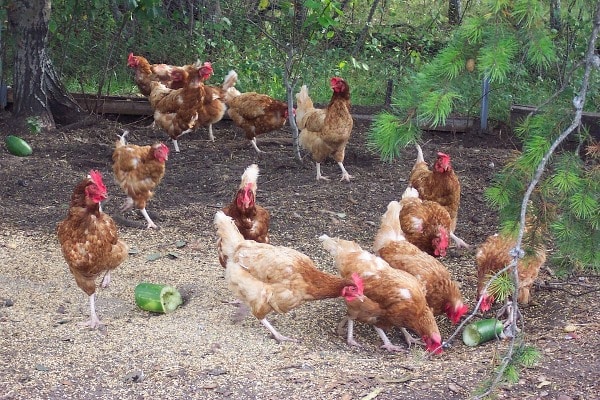
Floor Space for Country Chicken Breeds: Each chick brooding in the litter area needs 280 square centimeters area initially. Later on from the 6th week onwards, the floor space required is one square foot. Crowded brooding areas cause infection and increase the mortality rate of chicks. The feed conversion ratio, growth of the chicks, and the available floor space should all be proportional.
Light Management for Country Chicken Breeds: brooders are provided with light to increase consumption of food which helps in the growth of chicks. Light is provided continuously for 48 hours during the first 6 weeks. As the chicks grow light is provided for 10-12 hours and during the laying period, light is provided for 15 to 16 hours. Direct contact of the chicks with the light source has to be guarded. A cardboard or metallic guard of height 15 to 18” is placed as a guard around the hover at a distance of 3’.
Drinking Facilities for Country Chicken Breeds: Troughs are used to provide water to very young chicks and are maintained at a height of 2 cm. Bell-shaped water containers are used in the initial days of brooding.
Ventilation and Relative Humidity for Country Chicken Breed: when oxygen is reduced in the brooding area due to the accumulation of carbon dioxide and ammonia it results in the death of chicks at the brooding stage. The use of curtains can cause suffocation in the area, therefore 3.5 inches of headspace is allowed between the ceiling and curtains to facilitate air circulation. The relative humidity of the brooding area has to be maintained between 50- 65% to prevent dehydration of the chicks. The level of humidity can be maintained by spraying disinfected water.
Beak Trimming for Country Chicken Breeds: Beak trimming helps prevent feed wastage and cannibalism. Three fourth of the beak is trimmed during the 3rd week of chick. The beak of the chicks is trimmed by the method of Cauterization (melting the beak by hot iron). In this process, the tissues of the beak are destroyed and prevent beak growth. Care should be taken not to damage the tongue of the chick.
Litter Management for Country Chicken Breeds: Dry litter should be maintained and stirred regularly to help control diseases among the chicks. Temperature, humidity, and ventilation are regulated by the stirring action.
Health Care Management for Country Chicken Breeds: vaccination of the chicks has to be done regularly to avoid viruses and other diseases. The common diseases among birds are Ranikhet, Marek’s disease, fowl pox, and gumbroo. Other diseases that may occur in poultry birds are coccidiosis, infectious coryza, and salmonellosis. Internal and external parasites are treated by deworming the poultry flock.
Some Essential Tips for Country Chicken Breeds Farming:
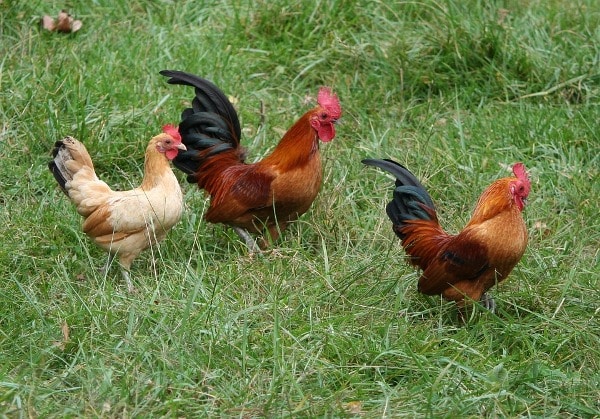
- Dual-purpose birds which are disease-free and have improved strain are preferred for backyard farming.
- Birds should be vaccinated regularly as and when required.
- Birds should be given healthy and fungus-free feed and water.
- The shed created for birds should be cleaned regularly to prevent moisture and humidity.
- Space for farming should not be congested.
- Different stages of birds should be reared separately in different sheds.
- Diseased birds should be isolated from the remaining flock.
- Equipment used in the farm for poultry should be disinfected and cleaned regularly.
- The shed should not be visited by outsiders and prevention has to be taken such that no animals enter the shed.
- New birds should be housed in properly cleaned and disinfected sheds.
- Curtains in the shed protect the birds from hot and cold weather. So curtains should be placed and maintained wisely.
Characteristics of Country Chicken Breeds:
- Rural area adaptability.
- Self-propagation.
- High brooding ability.
- Well built body.
- Hardy in nature.
- Good Scavenging ability.
- Well-developed coloured and attractive plumage.
- Self-defending capability.
- Disease resistant.
Country chicken farming can help improve the socio-economic status of farmers because it is a low investment venture and promises high returns. It also helps recover the nutrient and protein deficiency problem in the rural population. When poultry farming is done under acceptable methods and conditions favorable for the birds, then eventually it yields high profitable returns. Along with good poultry farming methods, good marketing strategies are also required to bring in profits. People who set up poultry farms can supply the chicken in the shops or hotels on a regular tie-up basis and improve their market demand for country chicken. Country chicken farming is practiced as a part of an integrated farming system which is a source of extra income to farmers and their households.
In case if you are interested in this: Quail Farming Business Plan.
- How to Make Houseplants Bushy: Effective Tips and Ideas
- Innovative Strategies for Boosting Coconut Pollination and Yield
- Pollination Strategies for Maximum Pumpkin Yield
- The Complete Guide to Chicken Fattening: Strategies for Maximum Growth
- Natural Solutions for Tulip Problems: 100% Effective Remedies for Leaf and Bulb-Related Issues
- Revolutionizing Citrus Preservation: Towards a Healthier, Greener Future
- Natural Solutions for Peony Leaf and Flower Problems: 100% Effective Remedies
- Maximizing Profits with Avocado Contract Farming in India: A Comprehensive Guide
- Natural Solutions for Hydrangea Problems: 100% Effective Remedies for Leaf and Flowers
- The Ultimate Guide to Choosing the Perfect Foliage Friend: Bringing Life Indoors
- From Sunlight to Sustainability: 15 Ways to Use Solar Technology in Agriculture
- The Ultimate Guide to Dong Tao Chicken: Exploring from History to Raising
- The Eco-Friendly Makeover: How to Convert Your Unused Swimming Pool into a Fish Pond
- Mastering the Art of Delaware Chicken Farming: Essentials for Healthy Backyard Flocks
- 20 Best Homemade Fertilizers for Money Plant: DIY Recipes and Application Methods
- How to Craft a Comprehensive Free-Range Chicken Farming Business Plan
- Brighten Your Flock: Raising Easter Egger Chickens for Beauty and Bounty
- How to Optimize Your Poultry Egg Farm Business Plan with These Strategies
- Subsidy for Spirulina Cultivation: How Indian Government Schemes Encouraging Spirulina Farmers
- Ultimate Guide to Raising Dominique Chickens: Breeding, Feeding, Egg-Production, and Care
- Mastering the Art of Raising Jersey Giant Chickens: Care, Feeding, and More
- Ultimate Guide to Raising Legbar Chickens: Breeding, Farming Practices, Diet, Egg-Production
- How to Raise Welsummer Chickens: A Comprehensive Guide for Beginners
- How to Protect Indoor Plants in Winter: A Comprehensive Guide
- Ultimate Guide to Grow Bag Gardening: Tips, Tricks, and Planting Ideas for Urban Gardeners
- Guide to Lotus Cultivation: How to Propagate, Plant, Grow, Care, Cost, and Profit
- Agriculture Drone Subsidy Scheme: Government Kisan Subsidy, License, and How to Apply Online